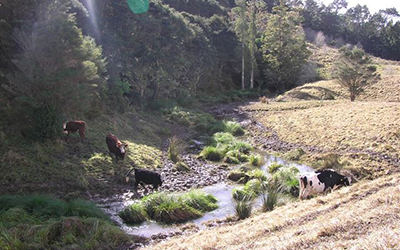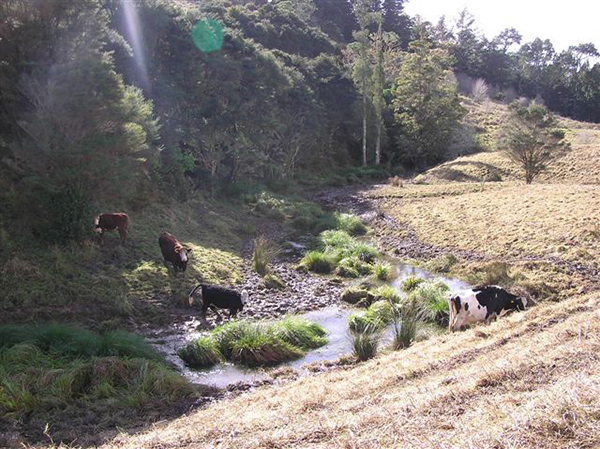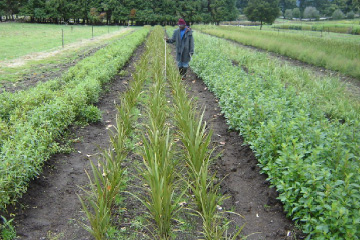Open-ground open day at Taupō Native Plant Nursery


More Trouble than it’s Worth: Cattle devastating Hepburn Creek. But the answer here is not riparian fencing—Telecom New Zealand wants to retire that uneconomic corner of its property completely. photograph Mahurangi Action
Taupō is a long way from the Mahurangi Harbour.
So why, the reader may wonder, this interest in the Taupō Native Plant Nursery. The full story is elsewhere, but briefly, it has everything to do with the elevated sediment accumulation rate in the Mahurangi Harbour.
The source of the sediment is mostly the catchment’s steep erodible pastureland, particularly when stocked with heavy beef cattle, and more particularly when such cattle have access to streams and wetlands.
Fencing riparian margins to exclude grazing farm stock is one response. Another is a change in land use, or to a non-commercial use—permanent retirement and indigenous revegetation. But if some ongoing productivity from the land is sought, forestry has the potential to generate much less sediment than pasture.
Obviously, not just any forestry. Radiata pine practices—clear felling and an absence riparian of protection—particularly if coinciding with heavy rainfall events, can be catastrophic to aquatic life downstream. Indigenous forestry, on the other hand, probably is close to optimal land use. The principal difference: the longer growing cycle, coupled with the vastly more valuable timber, means that much less destructive extraction processes can be deployed.
What is missing is an economical means of establishing quality indigenous forest—radiata pine costs about $1000 per hectare, whereas indigenous can cost between $30 000 and $40 000.
This is where the open-ground trial at Taupō Native Plant Nursery comes in. Some 6000 indigenous plants are being raised in open-ground beds there, using methods essentially those used to produce radiata pine seedlings. And while it is not expected that prices anytime soon be quite as low those for pine, around 30 cents each, there are additional benefits, including root systems free of circling, which can result in catastrophic failure after a decade or so of growth—literally a dead loss for the forest owner.
Taupō open-ground open day
Taupō Native Plant Nursery
Saturday 7 June 2008, 10.30am start

Essential Component: Tare Karae, a government indigenous forestry manager in Vanuatu, assisting with the open-ground trials at Taupō. Such in-kind contributions are essential to the project, given the Sustainable Farming Fund requires cash and in-kind inputs to match its own investment. photographer Michael Bergin
The open-ground plants at Taupō will take the breath away of anybody contemplating the challenge of establishing indigenous plants on a grand scale.
This is the first formal field day of the three-year Sustainable Farming Fund project titled Ōmaha Pilot Open-Ground Indigenous Plant Nursery.
The project was moved from Ōmaha to Taupō last year to take advantage of existing equipment and expertise at Taupō, and plans for the nursery to expand its open-ground production.
An outline of the programme appears below. Speakers will include:
- Ian Barton—Tane’s Tree Trust
- Dr David Bergin—dune, pōhutukawa and tōtara champion
- Jaap van Dorsser—forestry nurseryman extraordinaire
- Phil Smith—manager of Taupō Native Plant Nursery
All food and drink will be provided.
Transport will be provided from the Mahurangi, in a 12-seater bus. An early indication of numbers for the bus would be appreciated, as would be an indication of interest in returning on Sunday, via Jaap van Dorsser’s large-scale riparian restoration project Ngongotahā—accommodation costs are minimal.
Tentative Programme
- Cuppa and cakes
- Phil Smith Welcome to nursery
- Sustainable Farming Fund Ōmaha project
- Objectives and rationale re Mahurangi catchment (typical of many developed hill country sites, etc), first year at Ōmaha, second year progress in Taupō nursery, third year plans for more nursery and planting component.
- Ian Barton Tane’s Tree Trust role in promoting and supporting planting and managing native for multiple objectives—the trust has identified high cost of native tree seedlings as a major impediment to large scale planting of natives—is this project going to give community planting projects a practical cost effective alternative to containers?
- Lower North Branch of the Farm Forestry Assn.
- Jaap van Dorsser will give his wonderfully animated talk regarding pros and cons of open-ground versus potted plants.
- Ministry of Agriculture and Forestry Carbon update for planted indigenous forest.
12.30 Free Lunch Sausage sizzle plus biscuits, sticky buns, slices etc.
1pm onwards View open beds and potted seedlings combined with nursery tour.
2pm finish—for those needing to get away. - Cuppa and recapitulation
See also Open-Ground Indigenous Plants Report
